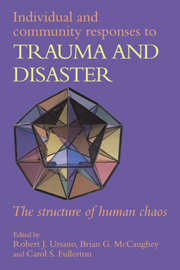Book contents
- Frontmatter
- Contents
- List of contributors
- Foreword
- Preface
- Part I Introduction
- Part II The nature of traumatic stress
- 2 The psychology of terror and its aftermath
- 3 Exposure to traumatic death: the nature of the stressor
- 4 Psychological and psychiatric aspects of technological disasters
- 5 Traumatic effects of accidents
- 6 The human experience of earthquakes
- 7 Psychological effects of toxic contamination
- Part III The role of psychosocial context in responses to trauma and disasters
- Part IV Responses to trauma across the life cycle
- Part V Conclusions
- Index
5 - Traumatic effects of accidents
from Part II - The nature of traumatic stress
Published online by Cambridge University Press: 13 October 2009
- Frontmatter
- Contents
- List of contributors
- Foreword
- Preface
- Part I Introduction
- Part II The nature of traumatic stress
- 2 The psychology of terror and its aftermath
- 3 Exposure to traumatic death: the nature of the stressor
- 4 Psychological and psychiatric aspects of technological disasters
- 5 Traumatic effects of accidents
- 6 The human experience of earthquakes
- 7 Psychological effects of toxic contamination
- Part III The role of psychosocial context in responses to trauma and disasters
- Part IV Responses to trauma across the life cycle
- Part V Conclusions
- Index
Summary
Empirical research indicates that the presence of physical injuries and suffering increases the prevalence and incidence of psychological and psychiatric problems after disasters and accidents (Gleser, Green & Winget, 1981; Malt, Blikra & Høivik, 1989a; Malt & Ugland 1989; Patterson et al., 1990; Raphael, 1986; Smith et al., 1990; Ursano et al., 1990). In a three-year retrospective study of 551 patients who were admitted to a surgical ward of a general hospital due to accidental injury, reduced physical function was significantly correlated with worse bodily health, and worse psychological health (correlation 0.299 and 0.498 respectively) (Malt et al., 1989a). Only one study reported no association between the severity of injury and psychological distress (Curran et al., 1990).
A number of war casualty studies also have shown that the frequency of psychiatric problems increases with the presence of physical injury (Chemtob et al., 1990; Crocq et al., 1990; Palinkas & Coben, 1987; Pitman, Altman & Macklin, 1989; Rundell et al., 1989; White & Faustman, 1989). Findings of the epidemiologic catchment area survey showed that about 3.5% of the nonwounded Vietnam veterans had a history of posttraumatic stress disorder compared to 20% in veterans wounded in Vietnam (Helzer, Robins & McEvoy, 1987). This difference was not explained by differences in combat intensity among the groups. Thus optimal planning and treatment of disaster and accident victims must include adequate knowledge and attention to the psychological and psychiatric aspects of physical injuries.
- Type
- Chapter
- Information
- Individual and Community Responses to Trauma and DisasterThe Structure of Human Chaos, pp. 103 - 135Publisher: Cambridge University PressPrint publication year: 1994
- 6
- Cited by



